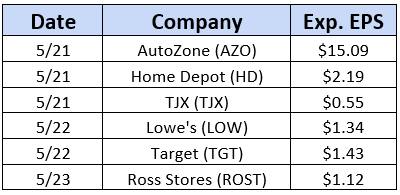The ongoing trade dispute with China frightened U.S. investors again on Monday, sending the Dow Jones Industrial Average down 617 points. However, markets were able to claw back those losses over the next three trading sessions.
While no resolution has been made between the two superpowers, the war of words has since quieted down. In addition, investors cheered solid earnings reports from blue-chips, like Cisco Systems (CSCO) and Wal-Mart (WMT).
Calculating the Tariff Cost
Still, President Trump has vowed to consider tariffs on another $300 billion of Chinese goods next month, if the two countries don’t agree to a truce by the G20 Summit in Japan. Deutsche Bank said this week there’s a 60% chance of the dispute reaching that level and Barclays believes there’s 10% downside potential for the markets, if the trade war escalates. As a result, we’re likely not out of the woods yet.
The tariffs being slung back and forth across the Pacific Ocean challenge each company differently, but there are other ways the trade conflict is affecting investors. For one, the U.S. yield curve inverted again this week; with the rate of 3-month treasury bills falling below that of 10-year notes.
The perception of slower global growth has also caused Fed funds futures to now price in a 51% chance the FOMC will lower interest rates at the September meeting, up from a probability of just 22% a month ago.
Retail Earnings on Deck
While the first-quarter earnings season is behind us, many retailers report on a different schedule and highlight the reporting calendar next week. Investors will certainly be keeping an ear out to see how these companies say they’re being affected by the tariff battle with China, given the amount of consumer goods imported by the U.S.

U.S. markets survived a double dose of dangerous headlines this week, in the form of China tariffs and an inverted yield curve.
Even though stocks recovered from Monday’s steep losses, volatility levels remain high. In fact, the CBOE Volatility Index (VIX) has regularly moved 10% (or more) daily, since the beginning of May.

While some investors believe the Fed will serve as a backstop and can lower interest rates in a pinch, this kind of news is especially troubling if you’re retired or planning on retiring soon. Rather than being concerned with trade concerns halfway around the globe, all you really care about is protecting your hard-earned nest egg and generating enough income to sustain a comfortable lifestyle.
Fortunately, there’s a better way:
My colleague Brett Owens has devised a strategy that removes the worry of trying to time the market, amongst a sea of volatility. Better yet, he’s composed a portfolio that generates an 8% annual yield, paying steady dividends each and every month!
8% is an impressive clip, when banks, bonds and vaunted Dividend Aristocrats are currently paying 2% or 3% at best. For every $500,000 you’ve saved up, Brett’s 8% Monthly Payer Portfolio will generate $40,000 a year of income.
Most companies pay dividends quarterly, but this portfolio is structured for monthly payouts. That works out to $3,333 a month, every month, whether the broader stock market averages are up 10% one year or down 10% the next.
$3,333 is a nice chunk of change. It pays a lot of bills each month if you’re retired… or is a nice supplemental income, if you’re sick of having earned next-to-nothing in “safe” investments over the past decade.
You don’t have to settle for just $40,000 a year, or $3,333 a month of dividends. If you have a cool million to invest, you could just as well generate $80,000 of income annually, or $6,666 each month!
Plus, a lot of the names in the portfolio have up to 10% upside potential. You can actually grow your nest egg, while these dividends are rolling in each month!
In order to get started, Brett will share his favorite monthly payers with you today, along with the name, ticker, and buy price for these stocks. Click here to get a full copy of our research on Monthly Dividend Superstars: 8% Annual Yields with 10% Price Upside, Too!
